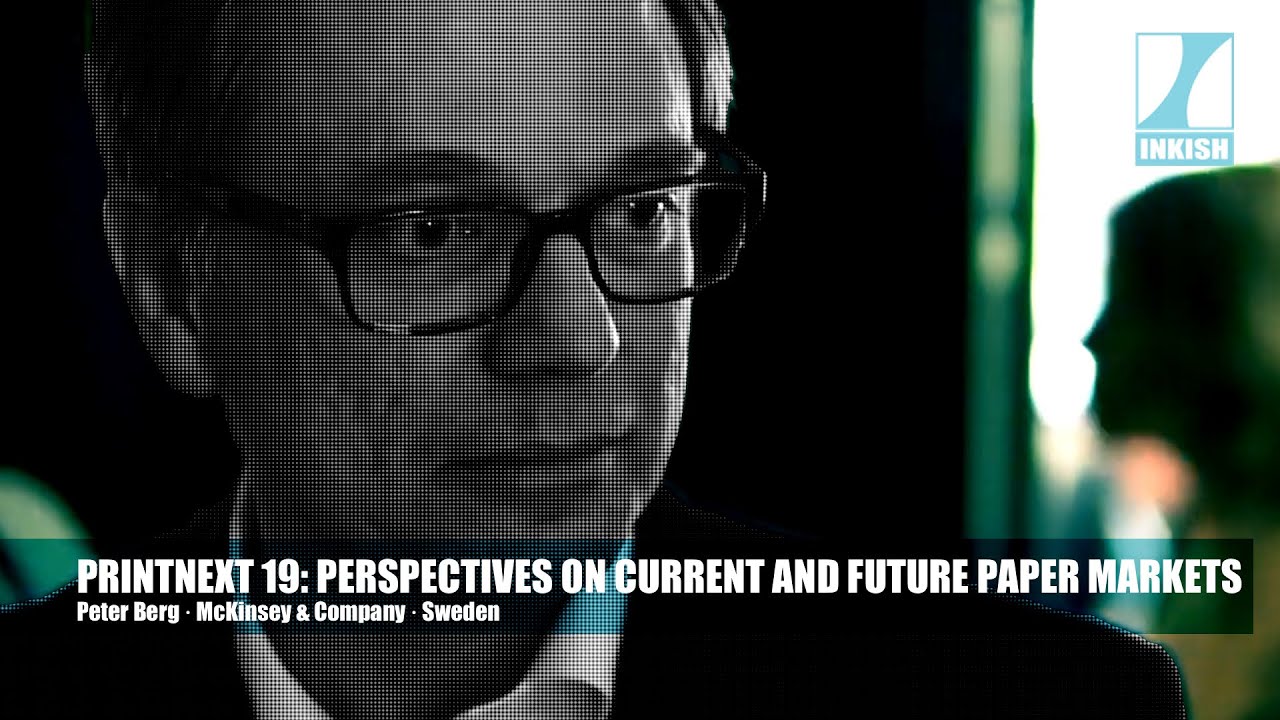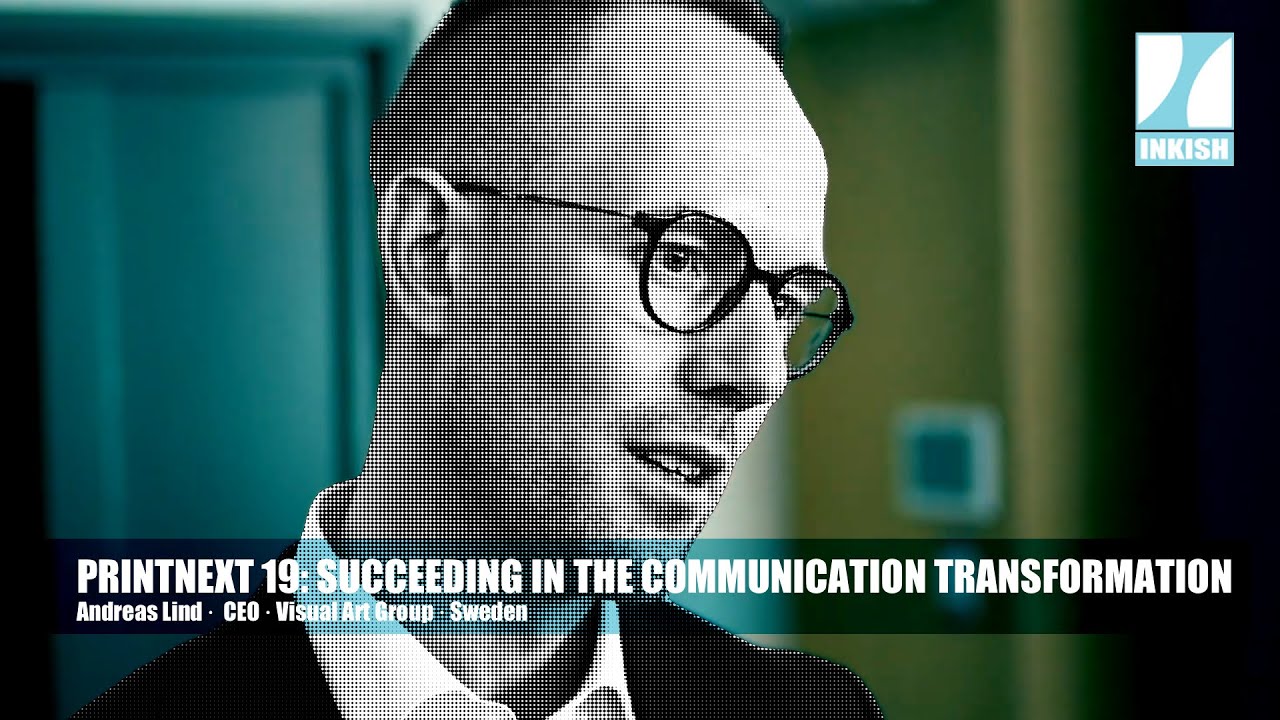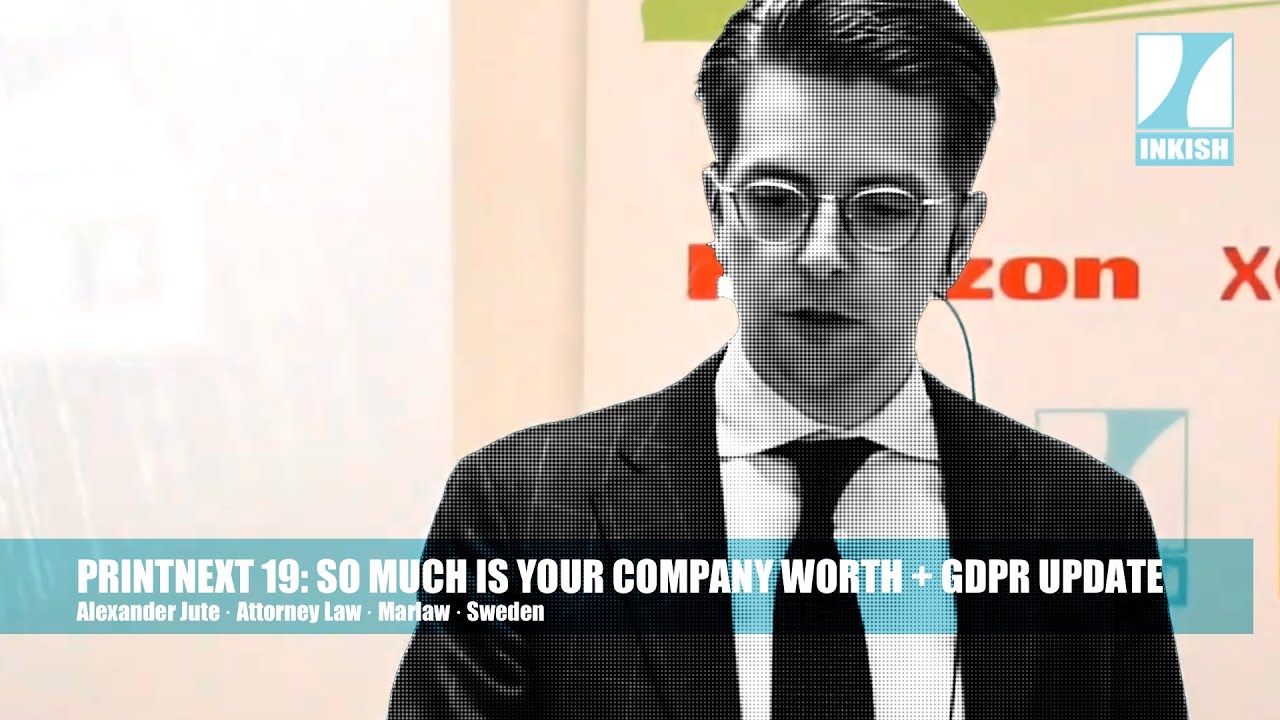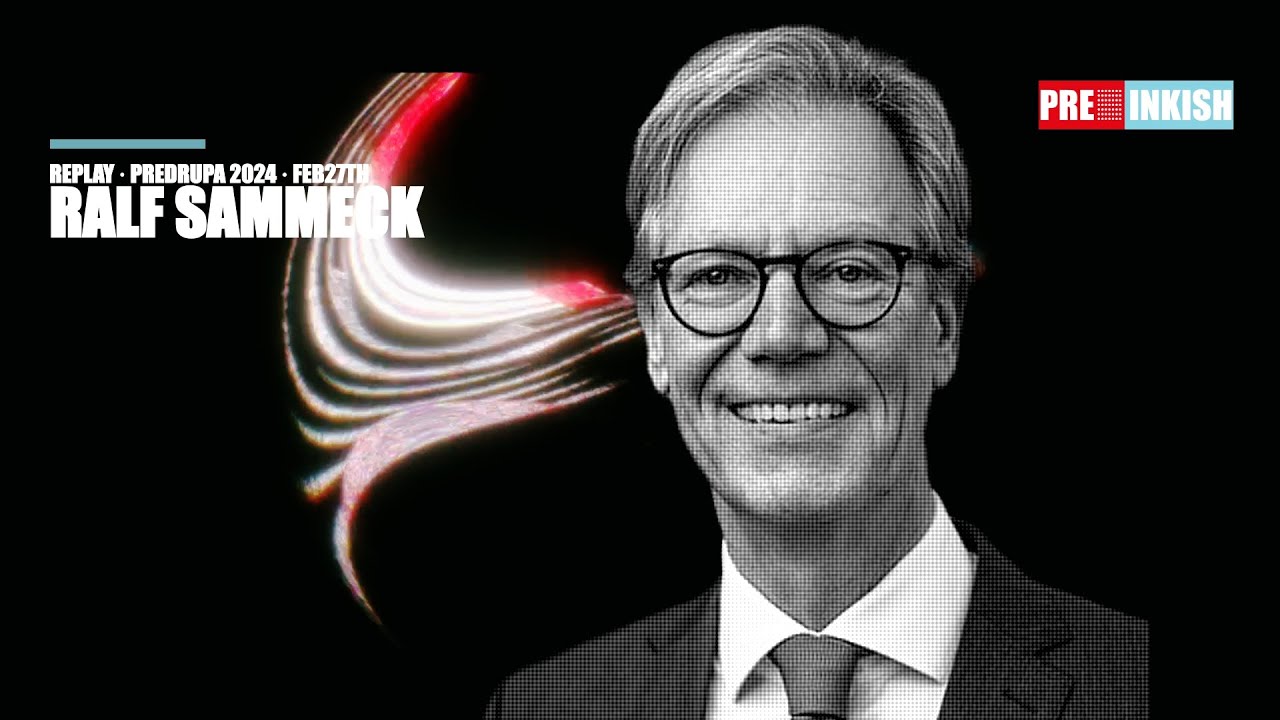PRINTNEXT19: Perspectives On Current and Future Paper Markets · Peter Berg · McKinsey & Company
Peter Berg from McKinsey & Company is a global expert in Pulp and Paper. At PrintNext19 he gave an amazing speech over why Paper Prices are increasing in time with decreasing demand. Understanding how paper mills are changing from one product to another product and how the pricing influences which mills changes are fascinating learning, and we believe that some of this info will be new to many viewers.
This is a MUST see speech!
Thanks. I co-lead sort of our global group around the paper and forest products industry, and I wanted to share a couple of perspectives with you on that industry, so your suppliers essentially. I wanted to do it in two different parts. One specifically around, or an overview, a perspective of trends. The important things that many of these companies in the paper and forest products and pulp and paper industry talk about. The second part going a little bit more into the dynamics of the printing and writing segment. As you know, it's no news to you, the demand is going down, but at the same time prices are going up. Why is that really? I wanted to hopefully shed a little bit of light on that. But, first of all, a couple of trends from the global industry. I've selected five different trends that we see as very important, and they are being discussed within the board rooms and with the management groups of various companies around the world. I guess you can, there's no big surprise in some of these, I think you could figure out some of them anyway. But, there is a lot of discussion around digitalization. All the way from forestry to sales, how they interface towards you, in an effort to make the value chain for effective. That also, one example of how that impacts is in packaging, which is a very dynamic part of the entire industry right now. There's a lot of interesting things happening in the consumer packaging as well as in the transport packaging segment of the pulp and paper industry. Where digitization redraws the value chain, e-commerce has a tremendous impact on how we think about packages in general, and where companies are finding new roles, new values to fill in that segment. The third one is around sustainability and resource productivity. How do we use the worlds resources in the best possible way, because we are indeed experiencing the Earth's limits in many ways. Both in terms of raw materials, but also in terms of for example it's ability to buffer CO2 in the atmosphere. One of the big discussions here coming on is around CO2, but also as we'll see lately around how we put too much waste if you wish into the environment. The fourth is around changing fiber dynamics, a bit of a tug of war between different kinds of fiber, and different kinds of users of fiber. I wanted to show you a picture or two on how that is playing out, and where China, big as it is and as a player in this industry, is kind of changing the game again. The fifth one is a little bit about growth. The demand growth globally. You probably heard about BRICs. Brazil, Russia, India, China. People don't talk about that [inaudible 00:03:06], they talk about ICA. India, China, Asia, and perhaps Southeast Asia as well. Partly because Brazil has been promising for the past 40 years, it hasn't really taken off. Russia has been difficulties taking off as well. So, you're kind of left with the regions that have tremendous amount of population, a billion people and more, and has some growth. That leaves us with India, China, Africa, and Southeast Asia. I wanted to touch a little but on that, but particularly on what happens with the Chinese demand for paper in the world. Illustrating that a bit, if I start with the digitization, this is a very schematic, illustrative view of the opportunities for digitization that we see across the entire value chain. From forestry all the way to sales for the pulp and paper companies. Much of this started if you wish in the saw mills, the pulp mills, the paper mills, where individual efforts to effectivize the manufacturing to reduce cost was the first thought and the first utilization of digitization. It has been spreading. There's quite a lot of talk about what we call precision forestry, so using digital means, advanced analytics, to manage the forest in a better way. Harvest it in a better way. Transport it in a better way to the users and the consumers. What we haven't seen yet to a large degree is sort of the downstream towards the market, again from the paper companies perspective. There are some discussions around digital paper markets and digital pulp markets, but it hasn't really come to fruition yet. What we definitely haven't seen yet, and will be extremely interesting when it comes, is a connection of all of these different parts. An end-to-end optimization of the value chain, where the data from the forest, knowing exactly which tree you've harvested and how you have managed it and made it grow in the best possible way, which tree goes to where. Because each individual plot and location will have their particular characteristics that has value in the pulp and paper making. But there I think we're sort of quite some distance away from that happening yet. Some of that digitization has an effect also on packaging, and here are a couple of interesting sub-trends if you wish within the packaging space. We see a lot of changing patterns for personal consumption. Us, we consumers, we go much more for convenience. We introduce a sustainability focus in how we buy things, even if it's coming slowly from a consumer perspective. We're finding out what we call new decision journeys, so the way we decide which kind of products we want to buy. It used to be that we always went to the store to buy things and that's where we looked at things and discovered prices and so on. Now, it's much more that we discover on internet and other digital means and then perhaps we go to the store to buy it, or we order directly over internet. In this world, packaging is finding new roles. Not only being a safeguard for whatever product is inside, or even sort of a good window for advertisement, but also an ability to follow the route of the product. To track and trace the packaging. People are talking about not the internet of things, but internet of packaging. To be able to check exactly what happens to my package throughout it's journey. One of the examples here, this is from the Chinese producer of board and packaging board for milk, that have individual QR codes for every single milk package, so they can trace where it goes. This is very important particularly in China which as you know has had a lot of difficulties with food scandals. It's not only that, but also being able to get information from us consumers by understanding what is our buying patterns. What do we do with things. From all of this there's a lot of interesting new collaborations happening between paper or board companies and technology companies, cloud service companies, in that whole space. This is related to the technology integration, going towards more intelligent packaging. Not only having sort of QR codes and being able to track and trace, but having sensors in the packaging that can tell me what temperature did my milk package go through in it's journey from more or less the cow to the consumer. Has my computer box been dropped while it's been transported? Lots of different kinds of technology that people are beginning to integrate with packaging. Then of course e-commerce, growth of the e-commerce channel. In Europe in most places e-commerce is in itself grows by roughly 10% per year. Varies from country to country. This has a tremendous effect on the packaging used in e-commerce. Essentially in over the next several years, more than half of the growth of transport packaging, so brown boxes essentially, will be driven by e-commerce. Most of that will be just normal brown boxes, but gradually there's a shift over to packaging that is specifically designed for the e-commerce channel. That was trend number two. Trend number three, un-sustainability. As you've known in the last several years we've seen a lot of increase in public and consumer pressure on companies for sustainability, on the packaging perspective. You've seen the, I think that first movie sort of on the nature of the world with tortoises eating or being sort of covered completely in plastic. We see news all the time with whales being sort of found on beaches with 40 kilograms of plastic in them, having eaten all of that in the seas, right. That has really stirred the feelings among many, many people all over the world, so there's been an increasing consumer pressure, and that has resulted also in a public pressure from regulators. From policy makers. In the EU we've said that we were going to set a limit for when we can have single use plastic, and there's a lot of different kinds of pressure being taken from policy makers perspective. Not only in the European Union, but also in other parts of the world. We have India being quite forward in banning plastic bags for example, many states in the US, even if not US as a federal country, is legalizing against plastic in various uses. The consumer goods companies are obviously following suit. They're making commitments in what they should do with their packaging, both in terms of using recycled materials in plastic for example, in making their packages more recyclable, and various other dimensions in how to make their packaging more sustainable. They're beginning to take action, it's a bit slow, it's not that fast, because it's not easy. It's an incredibly complicated question to dig into it, but something is happening. One thing to note, and this is of importance particularly for the pulp and paper industry, is that much of the action that is happening with consumer goods companies and from legislatures perspective, is actually on plastic. It's on making plastic better, because people are figuring out that for the time being we can't really be without plastic. It's such a tremendous material. It's form-able, it's lightweight, it's cheap. The only bad thing is that it consumes oil, so it releases CO2 when you burn it, and it creates all the waste in the environment when you throw it around. But, so a lot of the action here is around making plastics better. But, there is a lot of experimentation around materials, around fiber based materials, around using paper or board in new forms. Or, new parts of the wood if you wish, completely new bio-based materials for packaging. This creates both opportunities for the paper and board industry, as well as some threats. You can think for example of the second bullet point there. If you take a normal milk carton from when you buy milk or juice, or your normal coffee mug or Coca-Cola mug, that is normally covered with a polyethylene layer inside. There's a plastic layer inside. That plastic layer, depending on how thick it is, makes that whole package actually not really recyclable. Very difficult to recycle. There's a requirement from the European Union to look over and see what we can do about this. It depends on how thick the layer is. Sometimes you can put it back in the normal paper waste stream, and sometimes you cannot. Those are some of the things that the paper industry is looking at in earnest. Fourth trend on fiber tug of war as I call it, or the fiber dynamics. A couple of questions at different levels here. One is, who will actually be using fiber in the future? Well, it turns out quite a few different industries and sub-segments are interested. It's a little bit of a shabby tree there, I'm sorry for the drawing, but essentially you have the traditional paper and board industry on one hand, but you also have on the other hand both, call it traditional as well, wood panels, pellets for bi-energy. Which, even if it's not a big thing in Sweden is a growing thing in several Asian countries for example. As well as transportation fuels and also new bio-materials. There is a bit of a question, how will this balance play out in the future? We did a simple back of the envelope calculation looking at 2030. If you take the availability of soft wood fibers, from spruce and pine tree and so on, and the demands for soft wood fiber in the future. In turns out that by 2030, 2035 the risks being a bit of an overstretch in the demand for that fiber, compared to the supply that we have in our current forests and in the plantations that you'll find in New Zealand or Chili for example. That's at one level, sort of the discussions around sort of the tug of war of fiber. Another one is just around the daily dynamics if you wish of the fiber industry. One thing that has plagued many companies in the last couple of years, and I think you've probably got a whim of that as well, is around the cost of pulp for example. Many companies have complained bitterly since about 2017, and it's like, "What are we going to do?" Pulp prices just go up and up and up and up. Is this going to stop somewhere or do we need to take some drastic action, do we need to buy pulp companies ourselves? What do we do about it? There's been a lot of discussion around the price of the virgin pulp. It seems for now, and I'll come back to it a little bit later, that we've sort of passed that peak. This is a very cyclical industry. What we're seeing in the past two years is a fly up in prices that is not dictated by the normal steady state, micro-economics of the industry, but rather in a quite sever mismatch between supply and demand. That the industry couldn't sort of fix in a couple of years time. But it has also been dependent I think on a bit of psychology in the industry. Ever since China became a large country in the pulp and paper industry, it has introduced a different kind of psychology, because they're very opportunistic buyers of pulp and fiber and paper as well. That might have contributed to the very strong increase in prices that we've seen, but also the very fast decrease in prices that we've seen since the beginning of the year. On the other side, if you look at recycled fiber, prices have acted in a completely different way. This is again due to China, and there's no judgment in here, just sort of a fact base that China's actions, given how large it is as a producing and sourcing country, influences the rest of the world. What this shows is the prices of old corrugated containers, so old brown boxes, which is a globally traded commodity right. Used as recycled fiber to produce new container board, for new boxes. China over the past several years have gradually increased the requirements on what it imports, in terms of waste material. Both on fiber and on plastic as well. Now the rumor is, and it's a pretty solid rumor, that by 2020 they will actually stop completely any import of recycled fiber. What has happened, since China is the worlds largest producer of container board based on recycled fiber in the world, is that the prices in China of old brown boxes have gone through the roof completely. You see that in the upper line. At the same time of course, in Europe and North America, regions that have been exporting and still are exporting to China, price has gone down. Two different directions depending on what kind of raw material you are using. For the producers of pulp the last couple of years have been great. For the buyers not so much. But, for the producers of recycle based container board in say Europe, the past couple of years have been great as well. We think this is going to change. Sooner or later that sort of balance, the global balance of recycled fiber will even out. Somewhere, someone is going to need that recycled fiber. What's currently happening is that China is actually building up capacity for making container board outside of China and shipping into China. They're building up capacity for making recycle based pulp outside of China, shipping into China. So, there are ways of getting around. Finally, and I'll be brief on the fifth of the different trends here, on demand. One of the big questions is of course will India and Africa take off in the same way that China did. We don't quite see that yet. India has been hovering on a relatively low consumption of paper for quite some time. Africa's consumption of paper and board is ridiculously small to be honest still, and it has largely to do with GDP. At that level it follows GDP quite a bit. The interesting part in the near term is probably with China. How that acts and the expectations of demand in China going forward, and those expectations have been moderated quite a bit in the last 70 years. This is a bit of a complicated chart, but essentially what it shows is the expectations of demand in China for graphic paper and other packaging papers and so on in 2020. Every bar here shows the expectations of demand in 2020. The differences between the bars is when that forecast was made, and this is by an external forecasting institute, okay. Essentially in the most positive heydays in 2011, people thought that China by 2020 would consume almost 160 million tons of paper. That has been gradually revised down by almost 30%, so that by now when you are one year out or so, the expectations are that China would consume 45, 50 million tons less than we previously thought. There's a bit of reevaluation in China's consumption. China's GDP growth is also slowing down a bit, which will also add to this. That's a big ... Sorry, what is the current global demand? The current demand is somewhat below this. I'd say five or 10%, five percent below this, so about 100 million tons roughly. That's a big question mark in many peoples minds as well. Okay. That's chapter one if you wish. Now, let's dive a little bit into printing and writing papers. Some of this, the starting here I think you know all the way from the beginning. You've seen this before. It's interesting to note that the entire industry, the entire pulp and paper industry. With printing and writing papers, packaging, tissue papers, have slowed down a bit after the economic crisis in 2008, 2009. We used to have a global growth across the industry of about three percent. Now it's down to one percent. All segments do grow except the graphic papers. The printing and writing and newsprint. Newsprint is of course the one that's been most badly hit. Between 2010 and 2018 roughly six percent decline per year, in the newsprint segment. By now it's relatively small actually in comparison with the printing and writing segment, which also is in a slower decline. Some countries have held up better than others. This chart shows uncoated wood free papers specifically, [foreign language 00:20:50]. It's interesting to note that sort of the dark, or the black line here, Germany held up quite well in uncoated wood free papers until about a couple of years ago, and then also starting to go down. It's also a little bit scary to see that in over the past 15 years or so, many of these countries have reduced their consumption per capita. This is per capita on uncoated wood free by about half. 40%, up to about half. Big question is sort of will this stop, right? Is there a floor somewhere? We don't really know, but when we've asked around, when we ask various experts, they don't have a clear meaning either, but the synthesis of it is that no one really sees a floor coming. Is there a particular level at which we will still continue using paper? For the next 10, 15 years, yes. For sure we'll be using paper. It's not going to disappear over night, right. It's not like LP records or CD records, that actually more or less disappeared over a 15 year period of time. But it is over long periods of time unclear whether it will find a minimum level. But perhaps for the global industry, perhaps more disconcerting than this, is development in the developing economies. If this is a decline of graphic papers or newsprint and printing, writing in the developed economies, right? Whoops. The big expectations were on the growing economies, that they would kind of make up for the losses in the developing world. Well, they didn't. Around about sort of 2012, '13 or so, they also started not using as much paper. Largely because countries like China kind of technologically leapfrog from using printed paper to sort of readings that are all on the computer or iPhones or whatever. That is the bigger concern for the global industry. Then you can ask yourself, "If it looks like this, why do we pay more for the paper?" These are the prices of some common printing and writing papers over the past couple of years, and that's a bit of a nasty picture. We don't really like that, right, from your perspective. I'd like to get into a couple of the driving factors but of course one thing is also to just back off a little bit and see it from a somewhat longer distance. That growth we've seen and the prices in the last couple of years, if you take that in relationship to the decline in prices, so this is nominal prices, over a number of years, you see it in a little bit different perspective. But for sure those last two years have been painful, for not only you but for sort of many other segments as well. Why is that? That brings me to perhaps the most complicated chart of this half hour. I'll try to go through it as best as I can. This is a cost curve. It's a schematic cost curve. Essentially every single bar here I've taken away the dividing lines, but every single bar here is a paper machine making coated, wood free papers in Europe. The X axis shows how big the machine is, so this is perhaps 400,000 tons [inaudible 00:24:17], it's actually more than that. The total then is the total production of coated wood free papers in Europe. The Y axis shows the cost of production, because every single machine produces a different cost. The colors denote the kind of costs involved. The dark blue is the wood cost for those particularly in the Nordic regions that use wood directly in their production. The mid-blue is pulp cost, so when the machines and the mills buy pulp in order to make their coated wood free papers. The light blue is all other costs. Many of the segments of the pulp and paper industry are, at least at some level, fairly simple in their economics. It's a bit of a micro-economic sort of theory around it, which essentially says that the price that you find the market is roughly the cost of the highest cost producer, plus a bit of a margin, right. So, it's the cost of the marginal producer. Therefore if this line to the right here denotes the demand in a certain market for coated wood free papers, the price you will find in the market is roughly ... sort of when things have had time to settle, that this line over here plus a bit of a margin, so that the most expensive guys also earn some money. That's the theory behind and actually many segments in the pulp and paper industry work in exactly this way, at least over longer periods of time. Sometimes you see when the dynamics, when the mismatch between supply and demand sometimes gets too big, you can see fly ups. When prices go way above the cost of the most expensive producer, that is what you've seen in pulp in the last couple of years. There's no cost plus pricing in pulp in the last couple of years. It's actually been significantly higher than the cost of the marginal producer. What happens now in an industry where demand shrinks, this demand line here moves down, which means that those here that are sort of too expensive, in a sense they kind of get out of the market, right? The price of paper falls. You like that, the paper industry doesn't like that. What they try to do, sort of when they have mills that are around here and earn too little money they say, "Okay, can we do something else with this mill, right? Can we convert it to something else, can we shut it down?" In many cases the answer has been to sort of convert it into other kinds of products. Particularly into packaging. There's been a flow away from paper mills producing printing and writing paper, to mills producing packaging. What happens then is more example here, if you take this one, you take away a mill from this industry into some other industry, this whole cost curve shrinks. Which means this intersection point moves up again and prices go up. Sure, if you take out supply, prices will go up. This is a sort of a continuous balance that the industry is trying to make. Taking out capacity so that they from their perspective keep prices at a level that they like. That's one continuous factor, one big factor. The other factor that is important is what happens here? As I told you, the price of pulp has been going through a bit of a fly up situation in the last couple of years. This cost part here has become more expensive, and as you can see, it's mostly the most expensive producers that have a lot of pulp in their costs. The producers down here are not as much effected by that. What has happened is that sort of the whole right hand side of this curve, and the cost, production cost of the marginal producers have increased, and that pushes up the price as well. This is the dynamics that is happening here. Sort of both that industry is trying to find a balance between supply and demand, and the fact that you've been hit by increasing pulp prices that are higher than they normally would be. Just as a quick sort of example, they're telling me to shut up here. What has happened with the conversions from printing and writing paper to other grades. Over the past six or seven years about 8 million tons of capacity has either been shut down or converted into mostly packaging in Europe. That's the continuous struggle that is happening in this industry. Before [inaudible 00:29:11] takes me down here, just a couple of thoughts around what we can expect to see going forward. Our perspective is that we will continue to see a lot of sort of penetration from the digital side into many aspects of the industry, and many more than we can probably think of today. We will see a sustained or maybe even accelerated importance of sustainability on the industry, for good or bad, and in many cases it's an opportunity. We will also see a growing interest in wood raw materials from various kinds of bio-materials in the future. We think that pulp prices will cyclically move back as they've started to do, back from this fly up situation. The big question is when will we see a structural change, when this increased interest in wood as a raw material from different kinds of users will actually impact the price of pulp itself. We think we'll see a continued slide in demand for printing and writing papers. Question is there a floor? We don't know, but we will probably see still machine closures and conversions to balance that supply and demand. Most of the low hanging fruit picks of conversions have already happened, but there's still some that may happen. We will throughout all of this, and from all of this, we'll continue to see a paper and pulp industry that adapt and changes, and in 10 years time won't be looking the same as it does today. Okay. Thank you.








































































